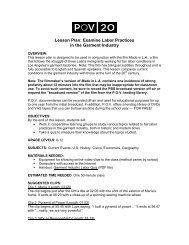Gender-Based Violence: Challenging Impunity - ITVS
Gender-Based Violence: Challenging Impunity - ITVS
Gender-Based Violence: Challenging Impunity - ITVS
You also want an ePaper? Increase the reach of your titles
YUMPU automatically turns print PDFs into web optimized ePapers that Google loves.
08<br />
HALF THE SKY<br />
<strong>Gender</strong>-<strong>Based</strong> <strong>Violence</strong>: <strong>Challenging</strong> <strong>Impunity</strong><br />
LESSON PLAN PROCEDURES<br />
Prescreening Activity (cont.)<br />
--<br />
Imagine that you knew before speaking out that your actions would probably not be<br />
successful or that no one would support you. How would you feel about taking action<br />
Write on your Post-it note all of the words that you can think of to describe how you might<br />
feel. Place your Post-it note on the graph in the area that indicates how likely you would<br />
be to speak out.<br />
--<br />
Imagine that you knew that you would be blamed, bullied, or shunned if you came forward.<br />
--<br />
Imagine that you found out that your family would suffer.<br />
--<br />
Imagine that you knew it was likely that you or the person you were helping would be in<br />
more danger as a result.<br />
• After completing the activity, discuss the results as a class, including the placement of the<br />
Post-its for each question and what can be inferred from the results.<br />
• Record the student feedback for reference later in the lesson.<br />
Part 2: Culture of <strong>Impunity</strong><br />
• Introduce the word impunity to the class. Have a student volunteer look up definitions<br />
in two or more sources and share their findings with the class. (Example: When people<br />
are able to commit crimes and/or violate the human rights of others without facing<br />
consequences.)<br />
• <strong>Based</strong> on these definitions, ask students what is meant by the phrase a culture of impunity.<br />
(Example: The term culture of impunity refers to a situation in which people in a society have<br />
come to believe that they can do whatever they want without having to face any penalties<br />
or punishments and victims of those actions are denied basic rights and/or protections.)<br />
• Variation: Students can use a word map to process their responses:<br />
www.readwritethink.org/files/resources/lesson_images/lesson307/wordmap.pdf.<br />
• Ask the students to identify which, if any, of the examples from the previous activity they<br />
think are indicative of a culture of impunity and why.<br />
• Ask students to share possible examples of impunity that they may have seen in the news,<br />
learned about in class, or experienced in their own lives. Examples could include the following:<br />
--<br />
Prior to the abolition of slavery, many states allowed slaveowners to treat enslaved people<br />
in any way they saw fit. No matter how horrendously owners treated, tortured, or killed<br />
slaves, the law would ignore the actions of the perpetrators and the victims had no legal<br />
rights or protections.<br />
--<br />
Since the digital revolution, there has been a major shift in the way that music is acquired.<br />
As of 2009, only 37 percent of music acquired in the United States was paid for. From<br />
2004 through 2009 alone, approximately 30 billion songs were illegally downloaded.<br />
• Using the students’ examples as a guide, have the class work in pairs (Think-Pair-Share)<br />
and brainstorm a list of factors that might contribute to the creation of a culture of impunity.<br />
• Complete the discussion with the following questions:<br />
--<br />
What impact would a culture like this have on an individual’s ability to feel empowered to<br />
speak out<br />
--<br />
What role do you think race, poverty, and gender might play in an individual’s ability to<br />
achieve justice

















